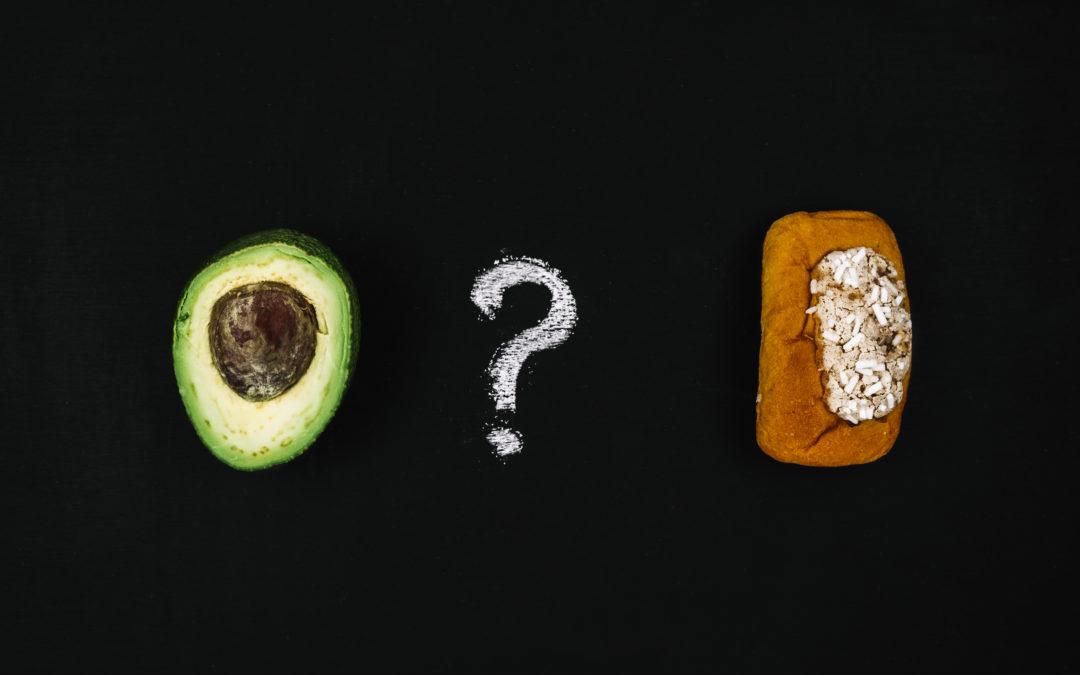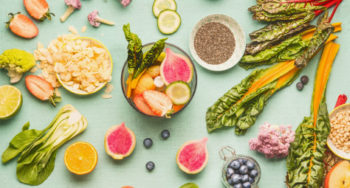Spoiler all. I’ll repeat one of my refrains… if someone is telling you 100% certainty about anything in nutrition, they are trying to sell you something. Epidemiologically, it is very difficult to do good studies, and what studies we do have are often conflicting. So no one has all of the answers and sometimes it is fuzzy still. However, I can say that the fat phobia of the 80s that is still ongoing is mostly unfounded (I said mostly). And since getting the right amount of fat is essential to not just your metabolic, biochemical and physiological processes, but also your WAIST LINE, I thought I’d make this week a #healthyfat education theme!
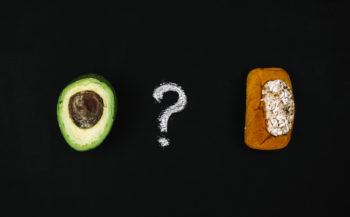
First, let's review what all the terms mean, and then we'll get into where this nutritional myth came from, and then about what to do next. BIG SUMMARY- what you call FAT on your body (cellulite, fat cells, obesity) is NOT the same as the fat you eat in food. Your first Wholist task for the week- you’ve got to separate these unfortunately named things from each other. ALSO, if the science of all of this freaks you out, don’t worry, in our coaching programs we provide this info in less detail so you understand the basis of the WHY, but we work on very practical steps and plans for you that you don’t need to know the organic chemistry LOL
I’ll get to body fat next, which we’ll call adipose tissue to provide some discrepancy and clarity. First dietary fat.
DIETARY FAT
"Fat" is a general term for various lipids and glycerols in food. Let’s break it down.
Triglycerides
Triglycerides are the main part of the fat that we eat. Basically, a molecule called glycerol bonded in various ways to three fatty acids, that - to be simple - we digest into glucose and fatty acids for use for energy. TRI = three fatty acids. GLYCERIDE = glycerol (that can be used to make glucose). They are also called triacylglycerols (especially when we talk about the triglycerides in our body)
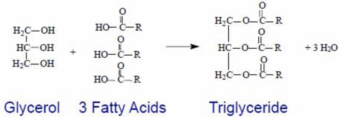
We break down triglycerides in the food that we eat, as noted to get the parts of it we need for energy and metabolism. If we have enough energy, the triglycerides might not be broken down (especially is we have given the body ‘easier’ energy sources like simple refined carbs/ sugars), then they float around in the blood or get stored in adipose tissue or fat. We can also remake triglycerides if we need to for storage. If you have too much triglycerides measurable in your blood, this is a risk factor for heart disease and other metabolic and cardiovascular syndromes.
“Saturation”
So you have three fatty acids and a single glycerol on each triglyceride. The difference between triglyceride types, and how good or bad they can be for you and what you can do with them or not, is dependent on what type of fatty acids are on the triglyceride. Depending on the bonding of carbons and how much hydrogen "saturates" the structure, we get different consistencies/viscosities of "fat”, and different effects on the food and the body. Obviously, the strength of these bonds and hydrogens are going to be a determinant of what food can do, what it does to your body and how you can use it. This is where we get into Saturated, Poly and Mono Unsaturated Fats.
For instance, "saturated fats" are triglycerides whose fatty acids that are not double bonded together but do have hydrogen "saturating" all of the carbons, so they are very stable structures with very thick viscosity (solid at room temperature) that can last a long time, cook at high temperatures and provide the texture we like to eat. Saturated fat examples include fatty animal meat fat and oils, lard, cream, butter, whole cheese and dairy (coconut oil as well). These are fats that we want to minimize for heart health in the long run. This is the category of fat with the MOST controversy between keto and plant-based folks. Saturated fats are used in keto help you stay full longer, and to help you avoid refined carbs, and to ‘trick’ you into getting efficient at using fat for energy (“fat adapted”) and lose weight faster….all of which is TRUE. Plant based folks will tell you a diet high in saturated fat from animals (and to a lesser extent dairy) are associated with higher rates of diabetes and heart disease (regardless of weight)…. which is TRUE. Stick with me. Learn about the rest of the fats and we’ll get back to this.
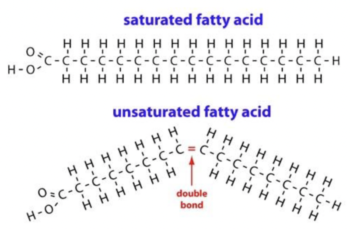
“Unsaturated fats" are triglycerides whose fatty acids have various numbers of double bonded connections between the glycerol and fatty acids, but have "holes" where the hydrogens are supposed to be, so are less stable structures. These are more oil like at room temperature and don't do well in oxygen (they go rancid). If there are lots of double bonded sections of the unsaturated fat, they are called polyunsaturated (poly = many). Only one double bonded section – monounsaturated (mono = one).
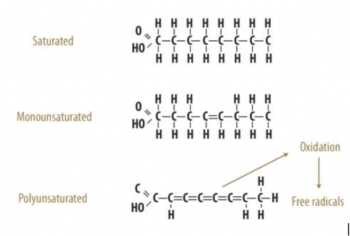
Healthy fats:
- Poly-unsaturated healthy fats are walnuts, chia and flax seeds, almonds, olive oil, wheat germ, tofu products, quinoa, salmon and other wild caught fish and shellfish, chickpeas, roasted, leaner meats, eggs, millet, avocado, brazil nuts, etc.
- Mono-unsaturated healthy fats are mostly oils - olive is the best as it is less processed. These are also in avocados and nuts/ seeds. Avocado oil is probably fine to use but the vegetable and nut oils are often hydrogenated into more inflammatory oils (more to come another week on anti-inflammatory diets).
Unsaturated fats can also be categorized into CIS unsaturated fats (those we eat from nature as noted above) and TRANS unsaturated fats (the way that we have learned to synthesize fats in industry) that were named just because of where the bonding is after a catalyst is added in the lab. Trans fats are basically natural cis-unsaturated OIL fats (like from vegetables or soy) that are force processed as a side effect of a contamination process by hydrogenating them so they are more stable for shelf life and melt at higher temperatures. Basically, processed catalyzed, partially hydrogenated vegetable fat oils and solids to make food last longer on the shelves. These have to be avoided because, as we'll discuss below, they are associated with heart disease. And have now been banned in the US as of 2018.
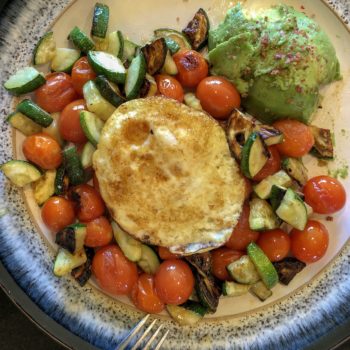
Glycerol & Fatty Acid metabolism
Fatty acids are one of the components of triglyceride “fat”. The glycerol is attached to the fatty acids, and is what holds or breaks those bonds up. These are important. When we digest good Cis poly or mono unsaturated fats, the glycerol is freed and goes to our liver to be made into glucose for energy when needed, and fatty acids are released as "free fatty acids".
Those fatty acids have different uses. Some are broken down in the body by enzymes to make different things that we need to run our processes. Some are called "essential fatty acids". Omega 3 and omega 6 being two commonly discussed polyunsaturated ones.
- Omega three are ANTI inflammation and help minimize heart disease and other inflammatory conditions. This is in flax, avocado, oily fish and walnuts.
- Omega sixes are thought to be mostly PRO inflammatory because they break down to a molecule that is really inflammatory. They compete for the same enzyme as omega 3 to be broken down. This is in processed vegetable oils, especially.
- Often, our diets are omega 6s 30:1 omega 3 modernly because of the processing of our food, which is one of the inflammatory issues we deal with in our food plans
What about cholesterol?
Dietary cholesterol is in animal food, meat, eggs, dairy and shellfish. All of those animals, like us, need to have cholesterol in their tissues because it is essential as a key building block in the membranes that surround all of the cells. However, only a bit of it is actually absorbed by our bodies (we absorb the fatty acids for energy but not so much the cholesterol). There is some controversy at this time about this, the ACLM and other plant-based proponents want to minimize trans-fat (yay!), saturated fat (yay!) and cholesterol (which I’m not so sure has been borne out).
Where DOES most of our body cholesterol come from? We MAKE our own cholesterol- it is manufactured in your liver for hormones, bile, vitamin D, etc. it is essential and needs to strengthen the membranes around our cells in nearly every part of our body. Nearly every cell can MAKE cholesterol as needed (except the brain - remember, it likes ketones). Once made, cholesterol is transported from the liver to the rest of you for its work. It is so essential that if you don't have enough cholesterol, your liver will make more. LDL is a carrier molecule that transports cholesterol and triglycerides from the liver to the other cells. If it is higher, it might mean you have a lot of body cholesterol from the liver that can blog the arteries in your body (although some LDL types might be actually protective). HDL is also a carrier molecule, but it brings the cholesterol and triglycerides from the body back to the liver - so out of the arteries - hence why it is a "good cholesterol".
Now we are getting to it.
WHAT IS BODY FAT?
Basically, body fat is a layperson term (and a terrible one) for adipose tissue. This is loose connective tissue in our bodies that are composed of adipocyte cells connected together by fascia and various other cells. It located beneath the skin (subcutaneous fat), around internal organs (visceral fat), in bone marrow (yellow bone marrow), intermuscular (muscular system) and in the breast tissue. White adipose tissue stores energy in the form of liver-generated (not diet generated) triglycerides/lipids, and brown adipose tissue that helps generates heat.
Around organs, it provides protective padding and under the skin it provides insulation from heat and cold. However, its main function is to be a reserve of lipids and triglycerides, which can be oxidized (broken down) to meet the energy needs of the body. Another goal is that it protects the body from excess glucose by storing it in triglycerides produced by the liver and in the adipose tissue itself.
Additionally, and SO COOL to think about is that adipose tissue is HORMONALLY ACTIVE and is basically another endocrine organ. It produces leptin for hunger, estrogen, cytokines, and a ton of other things related to your hormonal and hunger and energy balances. Under normal conditions, it provides feedback for hunger and diet to the brain.
This is one of the many reasons why I often tell my clients that
OBESITY IS A HORMONAL AND ENERGY DYSREGULATION PROBLEM.
THIS ISN’T A LACK OF WILLPOWER, BECAUSE YOUR BODY IS SMARTER THAN YOU.
IT IS A LACK OF SKILLPOWER.
Excess visceral fat is also linked to Type 2 Diabetes, insulin resistance, inflammatory diseases, cardiovascular disease polycystic ovarian syndrome, and other obesity-related diseases. Likewise, the accumulation of neck fat (or cervical adipose tissue) has been shown to be associated with mortality.
So, you can see that "body fat” is adipose, which is a hormonally active endocrine organ connected to the glucose storage in your body (mostly from sugars), reacts to store potential energy sources and to hormonally react with the rest of your body for its perceived needs. It is NOT THE FAT YOU EAT.
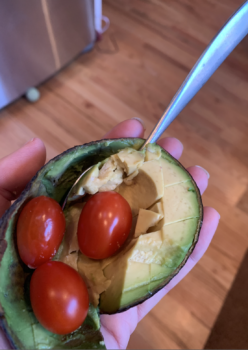
IS FAT BAD FOR ME? WHY IS EVERYONE TALKING ABOUT EATING SO MUCH FAT? I’M CONFUSED
- “Fat” is not bad for you. “Fat” in itself is a nonsense word.
- Processed trans-unsaturated triglycerides are bad you and likely carcinogenic.
- Animal based saturated triglycerides are not good for you for long term health.
- Plant based unsaturated triglycerides are good for you!
- You are hearing about it because of keto diets. This is because pure fats, like olive oil, do not stimulate insulin (like carbs and to a lesser extend protein does), so eating pure fats help give you “insulin vacations” that are linked to weight loss and weight maintenance. ). But few foods are eaten as pure fat. So, while I say "fats increase your insulin index but not nearly as much as everything else", it is likely that this is actually due to the proteins it is mixed with, not the fat itself. Also, the dose-response curve (what happens when you add in more and more of something) of fat is FLAT, so increasing higher and higher amounts of fats do not stimulate more insulin responses, while protein and carbs have an increasing dose-response curve (the more you eat, the more insulin is released). So, despite fat being more CALORIES, it stimulates insulin less. More importantly, because you aren’t eating simple refined carbs, you have to use your adipose stores to break down triglycerides for glucose to use for energy so you will be ‘fat adapted’ and burn off fat more efficiently. It also lets you stay full longer (eat less in the long run). It works! It can also be miserable for some, and hard to maintain for others. And using saturated fat as your primary fat is not going to be beneficial for long term health, especially animal meat based. You can be a keto plant-based person (it is just harder). You can always phase it, but you might need help from a coach.
- We don’t do keto on Wholist, but we do eat lots of healthy plant-based “fats”, we do eat some saturated triglycerids (dairy and coconut oil) to help with satiety and fullness and satisfaction, and we do utilize lots of keto ideas for food prep and recipes. I’m trying to balance what works, with long term health AND weight loss / maintanence as a goal.
WHAT AM I SUPPOSED TO DO WITH ALL OF THIS INFORMATION? LOL
Read it over and over. As you have questions, come back to it. Or email / PM me! Or post in Wholist Hammerstedt Health and Wellness Facebook Group so we can discuss with everyone!
Take aways:
- The “fat” you eat is not the “fat” on your body. You EAT triglycerides (and cholesterol) and you STORE excess sugar as triglycerides in your in adipose tissue cells.
- All fat is not bad. No trans fat. Minimize saturated fat for long term health. Maximize healthy plant based fats.
- Less refined process carbohydrates will get you to fat adapted, even without animal saturated fats.
- Healthy fats include: walnuts, chia and flax seeds, almonds, olive oil, wheat germ, tofu products, quinoa, salmon and other wild caught fish and shellfish, chickpeas, roasted, leaner meats, eggs, millet, avocado, olive oil, avocado oil, and nuts/ seeds (especially macademia, brazil, chia and flax)
Whew. Diatribe over. Enjoy #healthyfat week this week on @wholisthealth on social media and come join the party on our facebook group.
Namaste
Dr Heather
PS
Come join us for personal weight wellness coaching (this is seriously transformative stuff), my team is BADASS.
Or if you don’t need complete personalized attention and mindset work JUST for you, I do have a rare group coaching program starting April 1.
And as new FREE weight training webinar launching now, sign up HERE.
Lifestyle Medicine course for physicians, next online cohort, starts April 8
Other services, culinary, fitness, telemedicine consults, and online courses are HERE
As always, I’m all yours for a free discovery call to see if we might be just what you are looking for, pick a time here wholist.as.me/info15

